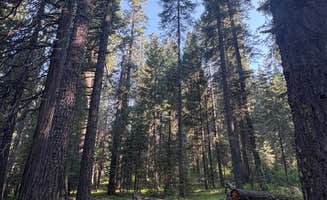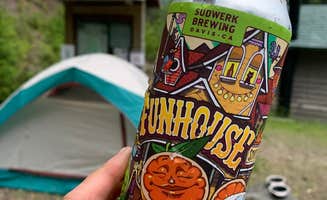Primitive camping near Helena, California primarily centers on Bureau of Land Management (BLM) and Forest Service land. These areas feature rugged terrain with elevations ranging from 500-3,000 feet and a Mediterranean climate with hot, dry summers and mild, wet winters. Most dispersed sites require campers to travel several miles on gravel roads with varying seasonal conditions that become impassable during heavy rain periods.
What to do
Wildlife viewing opportunities: Lacks Creek BLM offers excellent wildlife habitat with regular deer sightings. "We even pulled up our rear drop camper and had no issues at all," notes Luke D., who appreciated the surrounding natural areas for exploration.
Fishing access: Trinity River locations provide good fishing conditions for steelhead and salmon during season. At Wild and Scenic Trinity River Grapevine access point, campers find "great location off 299. 5 miles from Big Flat," according to Al L., making it convenient for anglers.
Hiking trails: The area offers hiking from easy to strenuous with minimal crowds. "There is a nice running/bike path right in the camp ground," notes Toni K. about Lacks Creek trails, though she cautions about ticks in the area.
Water recreation: During summer months, North Trinity Lake provides swimming and paddling opportunities. Karen T. describes it as "a beautiful open field with the woods in the back and Trinity lake in the front. You could camp in the open field or in the woods."
What campers like
Seclusion factor: Cline Gulch BLM Dispersed offers private camping with natural surroundings. "This is a good gravel road not far from main road. Lots of spaces along road. Not busy at all," writes Eric G., highlighting the quiet atmosphere.
Creek access: Several sites feature stream or creek proximity, adding natural ambiance. Jack W. describes Cline Gulch as "nothing special but it's the only BLM I could find in the area. We stopped on the way up to Shasta. You don't need ground clearance or 4wd to get there."
Diverse camping options: Sites range from forested to open meadows. At North Trinity Lake, Mckenna S. found "a perfect spot for a quick one night stay as we were passing through... Beautiful views at night and in the morning! It was wide open with no other campers in site."
Free camping: All BLM dispersed sites are free with typical 14-day stay limits. "There are multiple side dirt roads leading down to the lake from the main road so I would just look for those," advises Mckenna S. about finding North Trinity Lake camping spots.
What you should know
Road conditions vary widely: Many sites require high-clearance vehicles for safe access. "The road to get up there is a bit overgrown and there's a lot of potholes so just keep that in mind," warns Madeeha A. about Groves Prairie Dispersed Camp.
Cell service limitations: Most areas have minimal to no cellular coverage. "I had no service for miles with Verizon. Not just spotty service, literally nothing until I drove back down 15 minutes and camped on a road turnout," reports Scout G. about BLM Dispersed Camping at Lacks Creek.
Fire restrictions: Check current fire regulations as they change seasonally with complete bans during high fire danger periods. Rick F. notes about North Trinity Lake, "This is disbursed lakeside camping with no facilities," which includes understanding current fire rules.
Tick awareness: Ticks are prevalent throughout the region, particularly in spring and early summer. "I had a perfect spot right by the river... I was about to write a 5 star review... but then my dog and I both got bitten by ticks - and we woke to find 8 other dead ticks in our bed," reports Hillary S. about her stay at Cline Gulch.
Tips for camping with families
Choose established sites: For first-time primitive campers with children, select areas with minimal facilities. "The site is very secluded and well maintained," notes Greg B. about Groves Prairie, adding "There are 3 sites, each with a picnic table and fire ring. There is one vault toilet that was stocked with 'the papers'."
Wildlife encounters: Prepare children for wildlife interactions with appropriate safety measures. "We did have a few deer walking through our campsite through the middle of the night, and my dog loved chasing them away," shares Madeeha A. from her Groves Prairie experience.
Water availability: Bring sufficient water as potable sources are unavailable at most sites. "There is NO trash service or cans and NO POTABLE WATER. There is a tiny creek running nearby if needed," explains Greg B. about water conditions at Groves Prairie.
Weather planning: Summer temperatures frequently exceed 90°F, while winters can bring snow at higher elevations. "It was very hot too. We left after 30 minutes and 6 ticks," Jon E. writes about his June visit to Lacks Creek.
Tips from RVers
Size limitations: Most primitive sites accommodate smaller RVs better than large rigs. Jules S. warns about Lacks Creek BLM, "Tried to camp here with a 20ft travel trailer and I turned around before I even made it to the gravel road. Road is narrow and steep with low hanging trees."
Navigation challenges: GPS directions often prove unreliable in remote areas. Mckenna S. notes about North Trinity Lake, "The coordinates were off though and it took us up to a private residence road so I would not follow that."
Site selection for larger vehicles: Look for pull-through options on flatter ground. "Lots of space, there will certainly be a place for you when you pull in," Jack W. mentions about Cline Gulch, though other reviewers note limitations for larger rigs in the area.
Turnaround space: Scout pull-off areas before committing to narrow roads. Laura M. explains that at Cline Gulch, "The public road eventually dead ends about 2 miles in and turns into private property, at which point there's a large-ish space where you can turn around."





